This article has been contributed by Diana Adjadj.
Have you checked the latest figures on the freelance workforce? It’s getting very crowded out there.
According to the latest figures by Statista, there are almost 60 million independent workers in the U.S. alone. This is impressive considering that the gig economy was virtually non-existent just a decade ago. Now, the number of freelancers is projected to reach more than 90 million in less than a decade.
On top of that, the annual increase in the global freelance workforce keeps getting higher and higher.
To cut a long story short, the competition is about to get wild. Even well-established fully-booked freelancers are at risk because, well, there’s always someone who’s ready to do the same job (and for less money, too).
For you as an active and motivated freelancer, this means that you should think about how to invest in the long-term success of your business.
One of the strategies is personal branding, and we’re going to talk about how to use it to stand out from the increasing competition.
Why Personal Branding for Freelancers?
Chances are you’ve heard this many times before, but if you think about, building a personal brand as a freelancer makes perfect sense. It’s a known method for standing out from the crowd, and the freelance workforce is growing at the speed of light, which means you should be able to compete with skilled people from all over the world.
Personal branding has worked well for a lot of people in all industries. Some of the examples are really inspiring, so let’s talk a bit about one in more detail.
Kobe Bryant (rest in peace), five-time NBA champion, was a personal brand master.
Even though he played for 20 years in the NBA, he began building his personal brand only after his last game in the Lakers uniform. However, this time he went beyond selling t-shirts and signature shoes.
To be successful in business, Bryant relied on his personal brand, which, in turn, was fueled by the so-called “Mamba Mentality.”
To sum up what Mamba Mentality is, it means to be able to constantly try to be the best version of yourself, Bryant said in an interview.
“It’s a constant quest to try to better today than you were yesterday.”
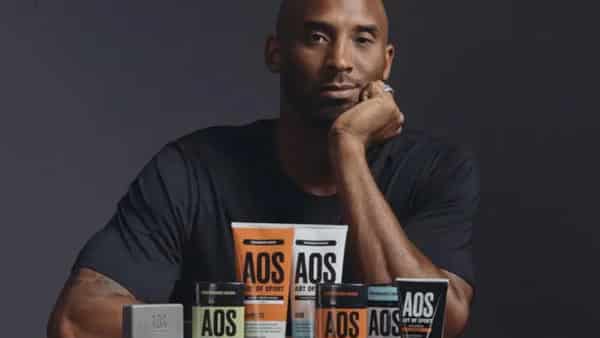
Known in the NBA as “Black Mamba,” he tried to use the same principles in business.
Shortly after the end of his career in sports, he started Art of Sport, a body care company for athletes, and he was in charge of crafting the launch scents. Bryant’s passion for athletics and performance was the primary driver behind the brand.
As a result, the history behind Bryant’s brand and his persona have become a powerful factor that differentiated Art of Sport in a crowded, $52 billion personal care market.
Even though the Art of Sport is a big company, it has some things in common with your freelance business:
It entered a crowded market and couldn’t rely on corporate image and branding, so Bryant used his own personal brand to give it a boost. In other words, they’ve chosen to use one person, their business manager, as their “face.”
As a freelancer, you’re in a super competitive business, too. Even though you’re not yet as famous as Kobe Bryant is, your personal story and portfolio are the only things you can rely on here.
This means a lot of work, so let’s get to it. In the next section, we’re going to share the best tips for personal branding for freelancers that you can start implementing today.
Launch Your Personal Brand in 5 Steps
1. Understand What a Personal Brand Is
While it’s easy to think that building a personal brand is sharing your epic life story, it’s not exactly like that. In fact, let me surprise you a little bit:
Your personal brand as a freelancer isn’t all about you.
It’s really about the way people perceive you, so your main purpose is to create and maintain a certain reputation (a reliable and skilled freelancer, for example).
But don’t just take my word for it. As Jeff Bezos famously explained,
“Your personal brand is what people say about you when you’re not in the room.”
We couldn’t agree more. A personal brand is a perception. For example, if sports fans think about people like Kobe Bryant, it’s not just that they don’t just know the name because you also have some feelings associated with this person (relentlessness, competitive spirit, dominance, i.e. “The Mamba Mentality”). The reputation associated with him affects his business as well.
So, to become a well-paid freelancer, you need to work on creating and maintaining a reputation. Just like big companies, you’re going to rely on your personal brand to ensure a high hourly rate and a steady flow of projects.
Now, let’s get to work.
2. Define the Name for Your Freelance Business
If you’re the one doing all the work, then the best way to go is to use your own name. It would be easier for you to get recognized and use it; besides, chances are that you’re already using it.
See our naming guide here.
Another great way to improve that is to add something that describes what you do. For example, freelance photographer Kelly Peloza does that with “Kelly Peloza Photo.” Short and to the point.

On the other hand, if you have a freelance agency that employs other people, consider giving it a unique name.
3. Build Your Own, Unique Online Presence
You can’t establish a personal brand without building a solid online presence. So, there are a few places to consider here:
- Your personal website
- Your social media profiles
- Your profile on a freelancing platform.
a. Website
The first option is to invest in your own website. Like a resume, it would be your personal business card online, which will also tell your story, share your expertise and services, and answer the question: “Why is this freelancer different from others?”
Here are just some of the reasons why your freelance business needs a website:
- With the number of freelancers rapidly increasing, a website would be a good way to stand out, catch eyes, and establish credibility
- It’s a great way to showcase your work. While freelance platforms and self-promotion websites like Dribbble are a must for sharing your portfolio, your own website is definitely the best
- It establishes your professional credibility and authority. Having a website is something that a lot of your competitors can’t afford or aren’t willing to do, however, many customers see a contractor with a personal website as more credible. Besides, by sharing content like how-to articles and tutorials on a blog, you’re also building your professional authority
- It gives your customers more ways to contact you. Live chat, email, blog comments – these are just some of the contact avenues that a website adds to a freelancer’s arsenal.
Feeling convinced? Well, then your next step should be developing a website.
If you’re wondering where to start in terms of content, try thinking about what your potential customers would want right away to make a decision to contact you.
For example, take a look at the website of freelance photographer Adam Wickham, below. He’s doing a great job of building a personal brand for a photographer.
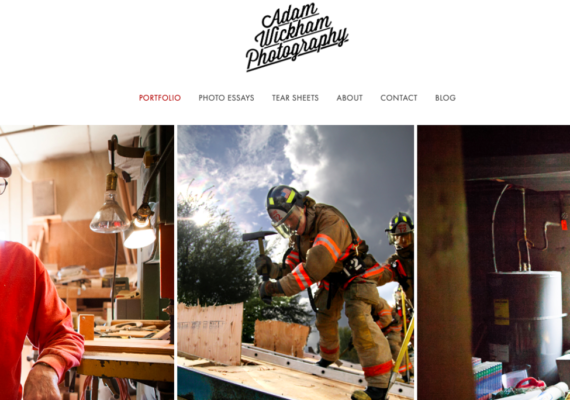
As you can see, there are only six items in the main menu: Portfolio, Photo Essays, Tear Sheets, About, Contact, and Blog. This gives the visitor – the potential client – a good choice of relevant options to select from.
Plus, the home page provides an introduction to Adam’s work by continuously showing some of his best photos in a stunning slideshow.
What do you need to know before creating a personal website?
While there’s no universal formula for a personal website menu, here are the essential things to consider:
- A dedicated portfolio section with subsections. For example, the Portfolio section on Adam’s website has five subsections: Editorial, Portraits, Lifestyle & Culture, Places & Neighborhood and Sports
- At least two options to contact you, e.g. a contact form and a social media page
- A clear and concise description of your services so clients can know what you can help them with
- Have a professional photo of yourself on the About page (this applies to all your personal profile photos)
- Your story. It’s a known fact that people find it easier to connect with other people, not companies, so you should “humanize” your brand even more by sharing your story on your website. In fact, brand storytelling has become something of an essential art form. You could have an “About Me” section where you concisely describe how you got to where you are now. For example, here’s a Boston-based interior designer Rachel Deider’s story as described on her agency’s site. Rachel does a great job of describing that she developed her passion for interior design at a young age as well as the experiences and cultures that influenced her own style. On top of that, it’s also good to read about her education and how she became a Bostonian (telling personal stories like this is exactly what “humanizing a brand” is all about).

- Awards and accomplishments section to showcase the recognition of your work (this also includes a list of clients). Here’s an example, courtesy of Bethany Mollenkof, a Los Angeles-based freelance photographer.

- Media mentions are also great accomplishments to share because they increase your credibility as a professional.Here’s an example from Adrienne Battistella, a freelance photographer who has been featured in numerous publications:
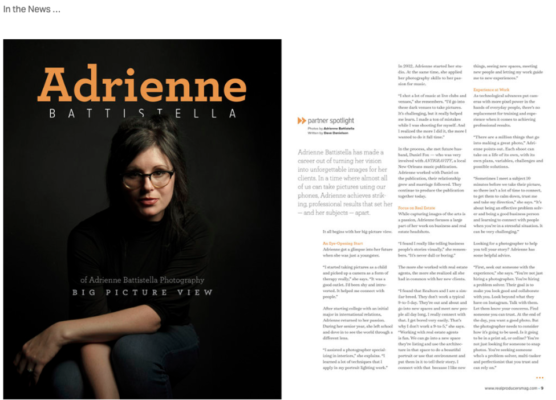
- Social media button integration to help potential clients message you there regardless of the page they’re on
- A blog. If possible, invest in the creation of content such as how-to articles, tips and stories. This makes it easy for people to connect with you plus increase credibility by showing your expertise. For example, you can blog about your thought process, the latest news, events, and recent and upcoming projects. Here’s how a blog entry from Adrienne Battistella shares her experience at a recent charity event in New York City, which makes a great post.

- Search engine optimisation can sound daunting to most of us, but there are creative ways of doing SEO. Do whatever tactics you can to rank as high as possible in Google searches.
b. Social Media
It goes without saying that you should have a profile on all popular social media platforms: Facebook, Instagram, LinkedIn, and Twitter. Social media is where your potential customers are, and meeting them there is something you need to do.
Here’s what to know to take advantage of social media for building your brand as a freelancer.
- Build your brand on Instagram by sharing photos at least a few times per week. It’s a great place to share both your and your customers’ stories through photos
- Try to engage followers by asking questions in posts, hosting giveaways, etc.
- Occasionally, promote your products and encourage your followers to visit your website and take a look at your portfolio.
- Post updates on your projects
- Share blog entries from your blog
- Write posts to thank clients and tag them there
- Share your accomplishments and personal stories
- Optimize your LinkedIn profile for keywords that your customers use to find professionals like you, i.e. “photographer Worcester, MA”
- Grow your professional network, look to have at least 500 connections (start with dream clients and people who view your profile)
- Optimize your About section with keywords and provide a link to your website or a self-promotion website, like on the example below
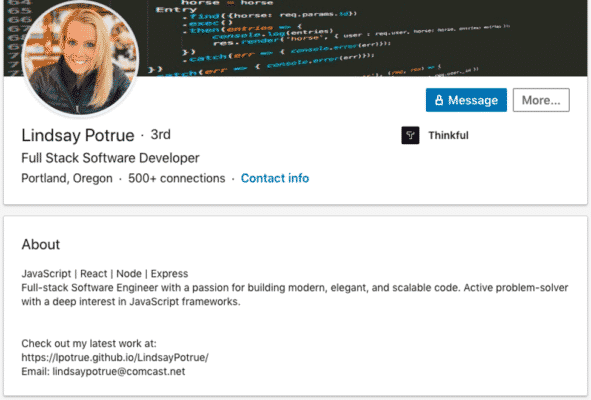
- Share relevant and high-quality content related to the industry, profession, etc.
- Provide a good description of your experience so potential clients know that you’ve got what it takes to do their job, like in the below example.
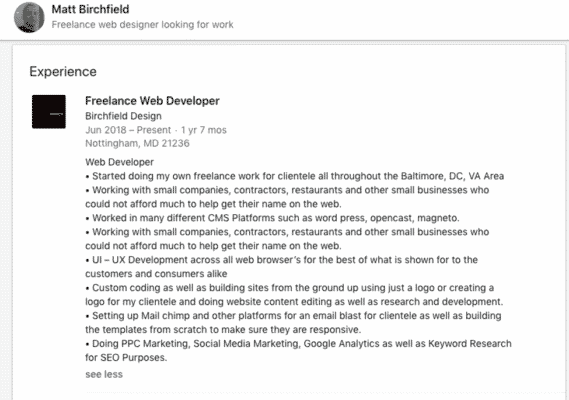
- Use your real name for the account to make finding your business easier
- Update your bio on a regular basis with personality-packed information and keywords
- Post updates on your projects.
c. Freelancing Platforms
Chances are that you have a profile on a freelance platform like Upwork, PeoplePerHour or Freelancer.com. It’s a big part of your career – it’s possible that profile was the starting point, too – so taking care of it is critical.
Here’s how to ensure that your profile works to build your brand:
- Optimize it for keywords
- Be as detailed and clear with experience description as you can
- Include some of the best projects to showcase your skills
- Ask your happy customers to leave good feedback.
4. Create a Content Strategy
We’ve mentioned content many times above, but your content strategy certainly deserves a dedicated section. Besides, chances are you have some content-related questions from the previous section, so let’s talk about what to create and how in more detail.
The importance of content is hard to underestimate when it comes to establishing a personal brand because it’s your main communication channel with potential clients. By consuming the content you produce, people can get to know your personality, expertise, experience, and interests.
Personal Descriptions
You may be the best designer in your city, but writing something like “Hey, I’m a designer” on your website or profile won’t get you very far. Make sure to list your qualifications but focus on what makes you especially attractive to potential employers.
Here’s an example from above that summarizes these tips beautifully.

Be Concise and Specific with Describing Portfolio Items
Clients want to know what kind of projects you managed and how you tackled them to decide if you can work on theirs successfully. To make a good impression, your description of portfolio items should be first and foremost clear and concise.
Here’s an example of a project description that has a number of sections for a customer to read and get familiar with the project.

Source: Diego Mancilla, freelance graphic designer
A great thing about this description is that the freelancer lets the viewers know about the goals and requirements of the project, all in a clear and concise manner.
“This is undoubtedly the best way to do product descriptions for a personal website and a profile on a self-promotion or freelancing platform,”
recommends Julian Mott, a web content writer at TopEssayWriting. “Long and detail-rich descriptions can be a bit boring for readers.”
Here’s an example 3-part structure description of portfolio items for you to consider:
- Problem: here you give a description of the business challenge faced by the customer
- Solution: explain the strategy you implemented to solve the problem
- Outcome: quantifiable metrics and results of the project (this might also include visuals).
Invest in Quality Visuals
High-quality visuals – your headshot, infographics, portfolio screens and images, targeted videos, and website images – are obviously important for and can help you to make your personal brand memorable. However, before proceeding to create them, you should have a good understanding of what kind of visual style you’d like to use.
- Every portfolio item should be accompanied by at least several high-quality screenshots, graphics, or images. Here’s an image from Diego Mancilla’s portfolio item featuring an app for athletes with a physical disability. In addition to images of the app on a smartphone, he also showcases fonts, color palettes, and a photo of his UX development process.

- Logo – if you want your brand to have one, be sure to make it simple and represent your personality. Here are the best logo design tips for 2020 to inspire you
- Use images and screenshots in blog posts on your website (or your articles published on Medium) to make them more engaging for readers. It’s a known fact that articles with images get twice as many shares as those without.

- The color palette for your website, business cards, and other branding materials: make sure that it has no more than 3 colors.
- The headshot you use across your profiles should neither play it safe (neutral facial expression, standard background, etc.) nor be a simple selfie. The best way to go is to make it something in between: for example, if you’re a web developer selling your software for B2B businesses, you want to play with the sense of nerdiness and professionalism in your headshot.
5. Be Genuine and Honest
The best way to build a personal brand as a freelancer is to be authentic, honest and promise only things you can deliver. No two people do the same job in the same way, and many people will definitely sense a disingenuous act from a mile away. That’s why you should try to design and write everything yourself where possible, as your distinct style of work and communication is something that sets you apart.
It’s Time to Build Your Personal Brand
The freelance economy is booming and the number of talented individuals you have to compete with gets higher every day. Even the best skills in the world won’t guarantee a steady flow of projects if your name is unknown. So gaining some recognition to let the world know about how unique and awesome you are is a way to make that happen.
That’s why building a personal brand to stand out from the ever-increasing pack could be a game-changer for your freelance business. It’ll be a lifelong project that constantly changes, but the outcome is so worth the effort. Hopefully, after reading the tips above, you know where and how to start this amazing journey!
_
About the author: Diana Adjadj is a professional blogger and copywriter who helps businesses to share their messages and connect with more people.
No comments:
Post a Comment